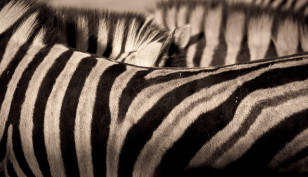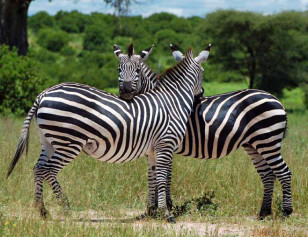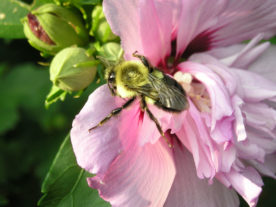Scientists say flies played a key role in the centuries-old mystery of how zebras came to have their distinguishing coat of black and white stripes.
Like humans and other primates whose fingerprints are unique to each individual, every zebra has its own distinctive set of striped markings.
The research team from the University of California, Davis tested five popular theories regarding zebras and their stripes and was able to reject all but one hypothesis.
Writing in Nature Communications, the researchers assert the zebra’s striped coating is the result of an evolutionary response to annoying and possibly harmful biting flies, such as horse flies and tsetse flies.
“I was amazed by our results,” said lead author Tim Caro, a University of California, Davis professor of wildlife biology. “Again and again, there was greater striping on areas of the body in those parts of the world where there was more annoyance from biting flies.“

Zebras developed their stripes to keep flies like the tsetse fly (left) and the horse fly (right) from biting them. (Alan R. Walker (left) Dennis Ray (right) via Wikimedia Commons)
Studies, including those conducted previously by the team, revealed that these fly species seemed to be most attracted to animals with dark solid coloring, while avoiding black-and-white striped surfaces. The researchers found these blood sucking flies were more attracted to solid dark surfaces that reflected light waves which were constant and oriented in the same direction. Scientists surmised the light waves reflected from dark surfaces were similar to those reflected from pools of water where the flies are known to lay their eggs. By contrast, striped surfaces might be less inviting to flies because they emit multiple light patterns.
The research team said evolution provided zebras with their stripes, while other hooved animals in the same vicinity remained stripe free, because the zebra’s hair is much shorter than the mouth part length of biting flies. This led the research team to think that zebras might especially vulnerable to the biting flies.

An close-up look at a zebra’s unique stripe covered coat. (William Warby via Flickr/Creative Commons)
“No one knew why zebras have such striking coloration,” Caro said. “But solving evolutionary conundrums increases our knowledge of the natural world and may spark greater commitment to conserving it.”
While the team solved one mystery others remain to be explained, such as what prevents these blood sucking flies from seeing striped surfaces as potential prey, and why are zebras, in particular, so vulnerable to these annoying insects.
Other theories as to why zebras have stripes include that the stripes protect them from attack by hiding them in the grass or by visually confusing their predators; that they serve as a form of heat management; or provide the animals with a social function.






















God’s Design! White and black stripes make the zebra easy to spot almost anywhere—especially for hungry lions. So why does it have them? These stripes make it tough for predators (even flies) to target zebras that move in a herd. This dizzying effect is called motion dazzle not evolution. You see the same striped predatory protection markings in other species – fish, birds and reptiles (and they are not affected by flies). It’s God’s design!
Ah, no. I believe that’s called called natural selection or evolution. God is not required to make that work.
yes easily seen with the human eye – but many other mammals do not see in color – maybe you should actually read the article rather than just spew your uneducated creationism muff cabbage
Many of the wild horses of the Pryor Mountain horse herd in Montana have zebra-like stripes on their backs, withers and legs: but there are not many flies in their high, dry area. There is legitimate and lively scientific debate on whether the genetic base of the Pryor herd dates back six centuries to feral Spanish horses, or whether it dates well over 14,000 years to the world’s original full-sized horse (genetic ancestor of the African zebra). So which came first….the striped zebra, swatting huge African flies; or the striped wild horse, who is not threatened by anything that flies? I suggest we come up with five totally wacky ideas, laugh heartily at the first four, and then declare the least laughable wild guess to be the winner.
Or, we can go with your theory; which actually does seem to make a lot of sense.
…besides, if there is a God, one can only hope he has something better to do than worry about the zebra’s annoyance with tetsi flies on some some unimaginably small and insignificant planet
Like how about giving us a solution to world hunger, the Ukraine crisis or at least a clue as to where flight 370 went instead of wasting time on zebra dermatology?
Actually, the more I think about it, you may be on to something here.
We humans have always had an inflated sense of self-worth. First we thought we were the center of the universe, then at the center of the solar system etc. All this has proven to be wrong. If God really attached such importance to humans, then WE would have the stripes to ward off mosquitoes and malaria etc. But we don’t.
So perhaps zebras are really God’s chosen animal and we humans are irrelevant.
God wasn’t concerned with flies on Zebra’s – the scientists were! Anyway and God already gave us His answer to world hunger …
Deuteronomy 15:11 ESV
For there will never cease to be poor in the land. Therefore I command you, ‘You shall open wide your hand to your brother, to the needy and to the poor, in your land.’
Isaiah 58:10 ESV
If you pour yourself out for the hungry and satisfy the desire of the afflicted, then shall your light rise in the darkness and your gloom be as the noonday.
Romans 12:20 ESV
To the contrary, “if your enemy is hungry, feed him; if he is thirsty, give him something to drink; …
Matthew 25:35 ESV /
For I was hungry and you gave me food, I was thirsty and you gave me drink, I was a stranger and you welcomed me,
My teen age son asks if this information supports those who say that zebras are black animals with white stripes.